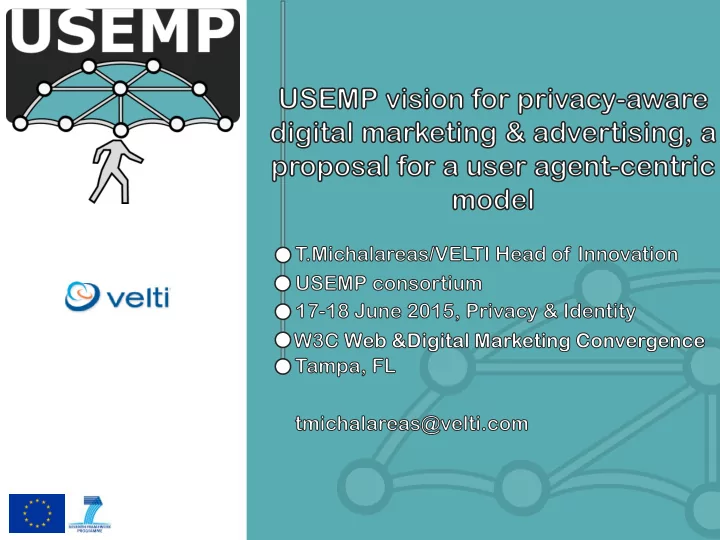

• USEMP (http://www.usemp-project.eu) is an EU multi-disciplinary research project • Perspectives from legal experts, engineers, computer scientists, marketing experts and social scientists on User Privacy • Develop tools & frameworks that help end-users understand what can n be infer erred ed from om the e persona sonal data ta sh shared ed in Social Networks and the web and what t is the value ue of the e data a they y are e sharing ring https://databait.hwcomms.com/
WEB and OSN users perception of privacy in Europe USEMP study on users’ attitudes on online privacy (Belgium; n=46; %)
Online e prese sence nce awarenes eness: s: feedback k and control: ol: a set of tools should be • available to improve online e management ement of p perso sonal nal data a enabling users to exercise their data protection and privacy rights and understand how they personal data are used and for what purpose • Econo nomic mic Value e Awaren eness: ess: feedbac ack k and control: ol: a set of tools should be available to raise users’ awareness concerning the economic value of the data they are sharing with digital marketing & advertising networks Profile le & Algori rith thmi mic c Transp spar aren ency: y: a set of tools should be available to help • users increasing their awareness how they are being targeted, categorized or profiled. • Data licens nsing ng agreement: ement: marketing and advertising networks should develop Data Licensing Agreement (DLA) that highlights the mutual commitment between the platform providers and the end-user following legislative framework in a clear and concise manner along with a set of tools to allow end-users to dynamically provide or withdraw their consent with for the use of their data under specified DLA.
How can digital marketing & advertising providers enable USEMP vision: transpar sparenc ency y of perso sonal al data use to the end-user er: it should be possible for the • end-consumer to understand which entity has access to which part of his/her personal data and for what purpose/action • transpar sparenc ency y of value e of shared ed perso sonal al data a to the end-user ser: it should be possible for the end-user to understand the value that their shared personal data generate • end-use ser dynam amic c consent: sent: it should be possible for the end-consumer to opt-in/opt- out his/her data dynamically to 3rd parties that wish to use them declaring their purpose transpar sparenc ency y of infer erences ences & class ssif ifica icatio ions to the end-user ser: : it should be possible • for the end-user to access the inferences & classifications that are related to his/her personal profile based on the data he/she has shared but also based on data shared by other end-users • innovati tive e busines ess s models: els: it should be possible to develop new business models for digital marketing and advertising where part of the generated value can be directed towards end-user
OSN user as a micro-publisher
Assumptions – more & more end-users will utilize either DNT or ad- blockers to reject advertisements (see for example ref. . 2) due to their sensitivity in they way their personal data are tracked and used Basic idea – Interest graph is computed locally by the browser – New type of targeting happens locally by the browser – Ads that use this type of targeting require access to the locally computed interest graph and this transaction is registered
web browser owser extensio nsion n that will be able to • compute, update and store the interest graph of a user based on his/her browsing history a a browser owser API that will expose and manage requests to access the interest graph to smart ads running • locally on the browser with the ability to generate and register transactionIDs these registered transactionIDs can be used for developing new business models where • the media advertising revenue is split between the publishers and the end-user a a smart adverts framewor ork k that wil ill allo low: w: ads to request information for the end-user interest graph in the absence of 3rd party • cookie support to get a transactio ionID that is registered also with the browser and can used for • registering clicks with the ad.server, this can be used for auditing (or reconciliation purposes) new busin iness mode del for advertisin ising g & marketin ing g can revenue be split with consumers • • can these transaction id piggyback to a blockchain-like pseudocurrency
a) a standardization of the interest graph ontology & data model for advertising & marketing purposes b) standardization of the metadata shared by publishers for constructing efficient interest graph computation algorithms c) a standardization of the useragent API and platform bindings for offering access to the interest graph smart ads
Recommend
More recommend